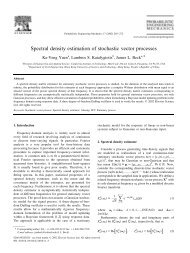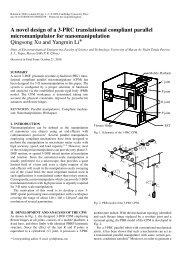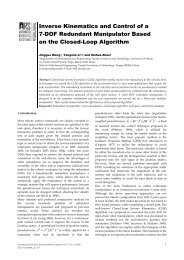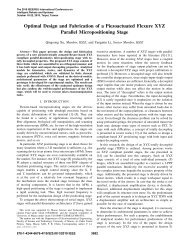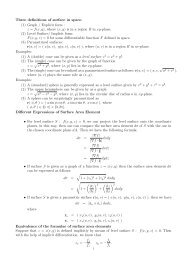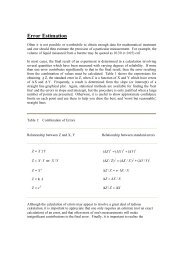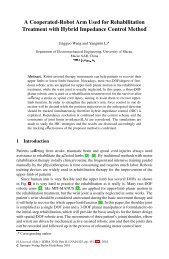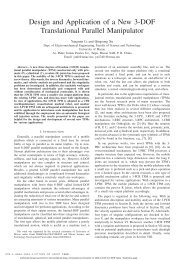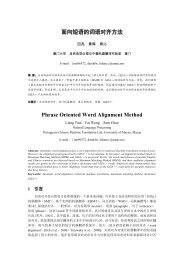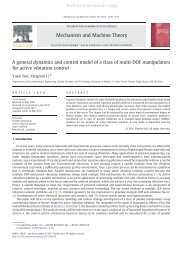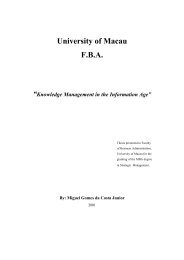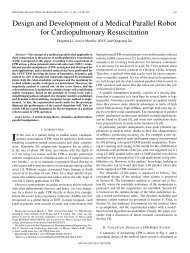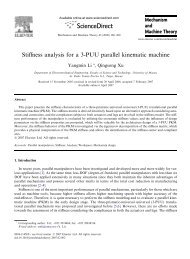lecture notes 13
lecture notes 13
lecture notes 13
You also want an ePaper? Increase the reach of your titles
YUMPU automatically turns print PDFs into web optimized ePapers that Google loves.
.Chapter 15 Vector Calculus.15.1 Vector Fields15.2 Line Integrals15.3 Fundamental Theorem and Independence of Path15.3 Conservative Fields and Potential Functions15.4 Green’s Theorem15.5 Surface Integrals15.5 Flux of Vector Field across Surface15.5 Divergence Theorem15.6 Stokes’ Theorem15.6 Simply Connected, Orientation15.6 Irrotational and Conservative Vector Fields.. . . . . .
.Surface Integrals.If the surface S is given by the graph z = z(x, y), where (x, y) lies inthe domain of D ⊂ R 2 , i.e. S√= { (x, y, z(x, y)) | (x, y) ∈ D }, then thesurface area element dS = 1 + z 2 x + z 2 y dxdy...If the surface S is given by parametric formr(u, v) = x(u, v)i + y(u, v)j + z(u, v)k, where (u, v) lies in the domainof D of uv-plane. Surface area element dS = ∥N∥dudv=∂r∣∣∂u × ∂r∣∣ ∣∣ ∣∣∣ ∣∣∣ ∂v ∣∣ dudv = ∂(y, z) ∂(z, x) ∂(x, y) ∣∣∣ ∣∣∣i + j +∂(u, v) ∂(u, v) ∂(u, v) k dudv. = √ (y u z v − z u y v ) 2 + (x u z v − z u x v ) 2 + (x u y v − y u x v ) 2 du dv..Definition. Let g = g(x, y, z) be a continuous function defined ondomain ∫∫ containing∫∫S, the surface integral√of the function g on S isg(x, y, z) dS = g(x, y, z(x, y)) 1 + z 2 x + z 2 y dxdy, orS∫∫D= g(x(u, v), y(u, v), z(u, v))∂r∣∣. D∂u × ∂r∂u ∣∣ du dv. . . . . .
.Definition. Let S be a parameterized surface or a graph, then thesurface ∫∫ area ∫∫of √S is given by1 dS = 1 + z 2 x + z 2 y dxdy, orS ∫∫ D= ∥r u × r v ∥ dudv..D.Example.Find the area of the part of the surface 2z = x 2 that liesdirectly above the triangle in the xy-plane with vertices at. A(0, 0), B(1, 0) and C(1, 1).Solution. The surface is a graph z(x, y) = x 2 /2 defined on the regionD = { (x, y) | 0 ≤ x ≤ 1, 0 ≤ y ≤ x }, then z x = x and z y = 0. Thesurface ∫∫ √area is1 + z 2 x + x 2 y dxdy∆ABC. . . . . .
.Definition. Let ρ(x, y, z) be the density (mass per unit ∫∫ area) of the asurface S in space, and the mass of S is given by g(x, y, z) dS..S.Example. Let ρ(x, y, z) = z 2 be the density function of the upper. hemisphere S : x 2 + y 2 + z 2 = a 2 , z ≥ 0. Find its mass.Solution. Write S as in the graph of the functionz(x, y) = √ a 2 − x 2 − y 2 , defined on the regionD = { (x, y) | x 2 + y 2 ≤ a 2 }. For any point (x, y, z) ∈ S, we havez = √ a 2 − x 2 − y 2 x, z x = − √ , and z ya 2 −x 2 −y 2 y = − √ . Thena 2 −x 2 −y 21 + z 2 x + z 2 y = 1 + x2 +y 2 a= 2. Moreover on S, we havea 2 −x 2 −y 2 a 2 −x 2 −y 2z 2 = ( √ a 2 − x 2 − y 2 ) 2 = a 2 − x 2 − y 2 . Then the mass of S is given by∫∫∫∫ρ(x, y, z) dS =S∫ 2π ∫ aD(a 2 − x 2 − y 2 ) ·√a 2 − r 2 r dr dθ = − 2πa2= a0[0= πa (a 2 − r 2 ) 3/2] a= 0 πa4 .∫ a0a√ dx dya 2 − x 2 − y2 √a 2 − r 2 d(a 2 − r 2 ). . . . . .
.Example. Let S be a parametric surface given byr(u, v) = x(u, v)i + y(u, v)j + z(u, v)k, where (u, v) lies in the domainof D of uv-plane. On S, define a vector fieldi j k∂x ∂y ∂(y, z) ∂(z, x) ∂(x, y)∂zN(u, v) = r u × r v = ∂u ∂u ∂u = i + j +∂x ∂y ∂z.∂(u, v) ∂(u, v) ∂(u, v) k.∂v ∂v ∂v.Proposition. The vector field N is continuous on S, and is normal tothe . tangent plane of the surface S everywhere..Definition. A parametric surface S given by r = r(u, v) is calledorientable if there is a continuous unit normal vector field n on S. Achoice of n is called an orientation of S, in this case, S is called an. oriented surface.For an oriented surface S with an orientation n, one defines the unitnormal vector field n(u, v) on S, byn(u, v) =N∥N∥ = 1 ( )∂(y, z) ∂(z, x) ∂(x, y)i + j +∥N∥ ∂(u, v) ∂(u, v) ∂(u, v) k .. . . . . .
.Surface Integral with respect to coordinate areaelements.Definition. Let g = g(x, y, z) be a scalar function defined on a domaincontaining S, define the surface integral of S with respect to thecoordinate x-axis, y-axis and z-axis respectively as∫∫∫∫∂(y, z)g(x, y, z)n · i dS = g(r(u, v)) du dv,SD ∂(u, v)∫∫∫∫∂(z, x)g(x, y, z)n · j dS = g(r(u, v)) du dv, andSD ∂(u, v)∫∫∫∫∂(x, y)g(x, y, z)n · k dS = g(r(u, v)) du dv,. SD ∂(u, v)n · i dS = 1 ( )∂(y, z)∥N∥ ∂(u, v) , · · · , · · · · (1, 0, 0) ∥N∥ du dv =∂(y, z)du dv = dx dy.∂(u, v)Remark. The jacobian factors are used to make the integralindependent of parametrization of the surface S.. . . . . .
.Surface Integral of Vector Field.Let F = (P, Q, R) be a continuous vector field defined in a domaincontaining a smooth oriented surface S, with unit normal vector field.Define the flux of F across S, or the surface integral of F over S as∫∫∫∫( )∂(y, z) ∂(z, x) ∂(x, y)F · n dS = (P, Q, R) · , , du dvS∫∫D∂(u, v) ∂(u, v) ∂(u, v)= P dydz + Q dzdx + R dxdy.. SRemark. If we change the orientation of S, the surface integral willchange by a minus sign.. . . . . .
.∫∫Example. Calculate the flux F · n dS, where F = k, and S is theSupper hemi-sphere z = √ a 2 − x 2 − y 2 with D : x 2 + y 2 ≤ a 2 , with the. outer normal vector field on S.Solution. ∫∫ As the flux of F = (P, Q, R) = (0, 0, 1) across S is given byF · n dS =∫∫S=(D∫∫D−P(x, y, z(x, y)) ∂z∂x1 dxdy = Area of D = πa 2 .− Q(x, y, z(x, y))∂z∂y + R(x, y, z(x, y)) )dxdyRemark. In the following, we directly compute F · n and dS in terms ofx and y.. . . . . .
.Example. Find the flux of F(x, y, z) = (x, y, 3) out of the region D. bounded by the paraboloid z = x 2 + y 2 and the plane z = 4.Solution. Let S 1 be the circular top { (x, y, 4) | x 2 + y 2 ≤ 2 2 }, and S 2be the parabolic part parameterized by z(x, y) = x 2 + y 2 withx 2 + y 2 ≤ 4 as shown in the diagram. In this case, the outward unitnormal vector field is given by on S 1 : n 1 (x, y, z) = k, and on S 2 byn 2 (x, y, z) = ∇(−z + x2 + y 2 ) (2x, 2y, −1)∥∇(−z + x 2 + y 2 = √ . In fact, one can)∥ 4x 2 + 4y 2 + 1check n 2 (0, 0, 0) = −1, so F 1 · n 1 = (x, y, 3) · (0, 0, 1) = 3, and(2x,2y,−1)F 2 · n 2 = (x, y, 3) · √ = 2x2 +2y 2 −3√ . On S4x 2 +4y 2 +1 4x2, the surface area2 +4y 2 +1√element dS = 1 + z 2 x + z 2 y dxdy = √ 4x 2 + 4y 2 + 1 dxdy for∫∫D = { (x, y) | x 2 + y 2 ≤ 4}. Then F · n dS =∫∫∫∫∫∫ S ∫∫F · n 1 dS + F · n 2 dS = 3 dxdy + (2x 2 + 2y 2 − 3) dxdyS 1 S 2 DD∫∫∫ 2π ∫ 2[ 2r= (2x 2 + 2y 2 ) dxdy = 2r 2 4· r dr dθ = 2π = 16π.4D00] 20. . . . . .
.Example. Suppose that a body has temperature u(x, y, z) at its point(x, y, z). The flow of heat in the body is described by the heat-flow. vector q(x, y, z) = −k∇u(x, y, z) for some constant k..Definition. Let S be a closed surface within the body bounding thesolid region D and let n denote the outer unit normal vector for S.Then the net heat flow across∫∫the sphere S out ∫∫of the region D acrossits boundary D is defined by q · n dS = − k∇u · n dS..SS. . . . . .
.Example. Suppose that a uniform solid ball B of radius R is centeredat the origin, and at its point (x, y, z) the temperatureu(x, y, z) = c(R 2 − x 2 − y 2 ). Find the rate of the flow of heat across. the sphere S of radius a < R centered at O(0, 0, 0).Solution. The heat flow across the sphereS ∫∫= { (x, y, z) | x∫∫2 + y 2 + z 2 = a 2 } is ∫∫ given byq · n dS = − k∇u · n dS = −k ∇(R 2 − x 2 − y 2 − z 2 ) · n dS =SSS∫∫∫∫(x, y, z)2(x−k (−2x, −2y, −2z) · dS = 2 + y 2 + z 2 )kdS =∫∫SaS a2ak dS = 2ak(4πa 2 ) = 8kπa 3 .S. . . . . .
.Divergence Theorem.Definitions. A surface S is called piecewise smooth, if it consists of afinite number of smooth parametric surfaces.A surface S is called closed if it is the boundary of a bounded solidregion . in space..Divergence Theorem. Suppose that S is a closed piecewise smoothsurface that bounds a space region D. Let n be the outer unit normalvector field, which is continuous on each smooth piece of S. IfF = (P, Q, R) is continuously ∫∫ differentiable ∫∫∫ on T, thenF · n dS = ∇F dV, i.e.∫∫S ∫∫∫ ( D∂PP dydz + Q dzdx + R dxdy =. SD ∂x + ∂Q∂y + ∂R )dV.∂zRemark. The condition that the surface S is closed plays a crucialroles in divergence theorem.. . . . . .
.Example. Let S be the surface (with outer unit normal vector n) of theregion D bounded by the planes z = 0, y = 0, y = 2 and the paraboliccylinder ∫∫ z = 1 − x 2 . Apply the divergence theorem to computeF · n dS, where F(x, y, z) = (x + cos y)i + (y + sin z)j + (z + e x )k.. SSolution. For any point (x, y, z) in D, we have 0 ≤ z ≤ 1 − x 2 , hence1 − x 2 ≥ 0, so x 2 ≤ 1, i.e. −1 ≤ x ≤ 1, hence we haveD = { (x, y, z) | − 1 ≤ x ≤ 1, 0 ≤ y ≤ 2, 0 ≤ z ≤ 1 − x 2 }.∇ · F(x, y, z) = (x + cos y) x + (y + sin z) y + (z + e x ) z = 1 + 1 + 1 = 3.Instead of evaluating the ∫∫ surface integral ∫∫∫ directly, we can∫∫∫apply thedivergence theorem that F · n dS = ∇ · F dV = 3 dV =SDD∫ 1 ∫ 2 ∫ 1−x 2∫ <strong>13</strong>dz dy dx = 3 × 2 (1 − x 2 ) dx = 6(2 − 2 3 ) = 8.−100−1Remark. Though we had not determined the outer normal vector fieldn, but it is necessary to know that n is pointing outward on theboundary S of the solid region D, before we apply divergencetheorem.. . . . . .
.Example. Let S be the surface of the solid cylinder D bounded by theplanes z = 0, ∫∫ z = 3 and the cylinder x 2 + y 2 = 4. Calculate theoutward flux F · n dS, whereSF(x, . y, z) = (x 2 + y 2 + z 2 )(xi + yj + zk).Solution. Note that the divergence ∇ · F(x, y, z)= (x 3 + xy 2 + xz 2 ) x + (x 2 y + y 3 + yz 2 ) y + (x 2 z + y 2 z + z 3 ) z= 5(x 2 + y 2 + z 2 ). It follows from the divergence theorem and thenuse ∫∫ cylindrical∫∫∫coordinates that∫∫∫F · n dS = ∇ · F dV = 5(x 2 + y 2 + z 2 ) dVS∫ 2π ∫ 2 ∫ 3=5(r 2 + z 2 ) r dz dr dθ0 0 0∫ 2[= 10π r 3 z + 1 ] 30 3 rz3 dr = 10π0[ 3= 10π4 r4 + 9 ] 22 r2 = 300π.0DD∫ 20(3r 3 + 9r) dr. . . . . .
.Example. Let S be the sphere x 2 + ∫∫y 2 + z 2 = 4, which bounds a solidball D. Calculate the outward flux F · n dS, whereF(x, . y, z) = (x 2 + y 2 + z 2 )(xi + yj + zk).Solution. Note that the divergence ∇ · F(x, y, z)= (x 3 + xy 2 + xz 2 ) x + (x 2 y + y 3 + yz 2 ) y + (x 2 z + y 2 z + z 3 ) z= 5(x 2 + y 2 + z 2 ). It follows from the divergence theorem and thenuse ∫∫ spherical coordinates ∫∫∫ that ∫∫∫F · n dS = ∇ · F dV = 5(x 2 + y 2 + z 2 ) dV==S∫ 2π ∫ π ∫ a∫0a0005ρ 4 dρ ×D5ρ 2 · ρ 2 sin ϕ dρ dϕ dθ∫ π0sin ϕ dϕ ×∫ 2π= a 5 × [1 − (−1)] × 2π = 4πa 5 .0DdθS. . . . . .
.Example. Let D be a solid region bounded by a smooth parametricclosed surface S, with the outer unit normal vector field n to S. Provethat the volume of D is 1 ∫∫x dydz + y dzdx + z dxdy..3 SSolution. Let F(x, y, z) = (x, y, z), and ∇ · F(x, y, z) = ∇ · (x, y, z)= (x) x + (y) y + (z) z = 3. Then it follows from the definition of fluxintegral and divergence theorem that 1 ∫∫x dydz + y dzdx + z dxdy =∫∫3 S1F · n dS = 1 ∫∫∫∇ · F dV = 1 ∫∫∫3 dV = volume of D.3 S 3 D 3 D.Example. Let V and A be the volume and the surface area of thesphere . of radius a centered at (0, 0, 0). Prove that 3V = aA.Solution. Let S be the sphere given by { (x, y, z) | x 2 + y 2 + z 2 = a 2 },(x, y, z)hence the outer normal vector n(x, y, z) = . Then 3Va= 1 ∫∫∫∫x dydz + y dzdx + z dxdy = (x, y, z) · n dS =∫∫3 SS(x, y, z)(x, y, z) · dS = 1 ∫∫∫∫(x 2 + y 2 + z 2 ) dS = a dS = aA.a aSSS. . . . . .
.Example. Show that the divergence of the continuously differentiable∫∫1vector field F at the point P is given by ∇ · F(P) = lim F · n dS,r→0 |B r | S rwhere S r is the sphere of radius r centered at P and |B r | =3 4 πr3 is the. volume of the ball B r that the sphere bounds.Solution. As F is continuously differentiable at P(a, b, c), so ∇ · F iscontinuous at P. Then for any ε > 0, there exists δ > 0 such that|∇ · F(x, y, z) − ∇ · F(a, b, c)| < ε for all point (x, y, z) in the open ballcentered at P(a, b, c) with radius δ > 0. Then∣ ∇ · F(P) − 1 ∫∫F · n dS|B r |∣ = 1∫∫S r |B r | ∣ |B r|∇ · F(P) − F · n dS∣S r= 1∫∫∫∫∫∫|B r | ∣ ∇ · F(P)dV − ∇ · F dS∣B r B r= 1 ∫∫∫|∇ · F(P) − ∇ · F| dS < 1 ∫∫∫ε dV = |B r|ε = ε, and|B r | B r |B r | B r |B r |hence the result follows..Remark. Let F be a vector field defined on a region containing a point. P, then P is called a source if ∇ · F(P) > 0, and sink if ∇ · F(P) < 0.. . . . . .
.Example. The outward flux of vector field F(x, y, z) = xi + yj + zk. across the sphere x 2 + y 2 + z 2 − 2x − 2y − 2z = 3 is .Solution. Let D be the solid bounded by the sphere, then fromdivergence theorem we have the outward flux of F is∫∫∫∫∫∫∫∫F · n dS = ∇ · F dV = ( ∂xSDD ∂x + ∂x∂x + ∂x∂x∫∫∫D) dV = 3 dV= 3 volume of D = 3 × 4( √ 6) 3 π/3 = 24π √ 6.. . . . . .
.Example. Let F(x, y, z) = (x, y, z), and T be the surface defined by{ (x, y, z) ∈ R 3 | |x| + |y| + |z| = 1 }, with outward ∫∫ pointing unitnormal n on T. Evaluate the surface integral F · ndS..TSolution. Let D be the solid bounded by the surface T, i.e.D = { (x, y, z) ∈ R 3 | |x| + |y| + |z| ≤ 1 }. One can check that thecondition of the divergence theorem holds, and hence∫∫∫∫∫∫∫∫F · ndS = divFdV = ( ∂xTDD ∂x + ∂x∂x + ∂x∂x ) dV∫∫∫= 3 × dV = 3Vol(D) = 3 × 8 × 1 3! × 1 × 1 × 1 = 4.D. . . . . .
.Example. Let T be the solid cylinder defined by the inequalitiesx 2 + y 2 ≤ 1 and 0 ≤ z ≤ 4. Let S be the entire boundary of T. Let. F(x, y, z) = (5z + 3)k. Find the outward flux of F through S.Solution I. Let S 1 = { (x, y, 4) | x 2 + y 2 ≤ 4 } be the top of T, andS 2 = { (x, y, 0) | x 2 + y 2 ≤ 4 } be the bottom of T. The outer unitnormal vector field on S 1 and S 2 are n 1 = k, and n 2 = −krespectively. The outward flux of F throughS 1 = ∫∫ SF1· n dS = ∫∫ S(51× 4 + 3)k · k dS = 23×Area of S 1 = 23π.The outward flux of F throughS 2 = ∫∫ SF2· n dS = ∫∫ S(52× 0 + 3)k · (−k) dS = 3×Area of S 2 = 3π.The flux through the curved part of the boundary is 0 since n ishorizontal there, so F · n = 0, So the total flux of F across S is23π − 3π = 20π.Solution II. We have div F ∫∫ = 0 + 0 + 5 = ∫∫∫ 5, so by the divergencetheorem, the flux equals F · n dS = ∇ · F dV = 5× Volume ofT= 5 × π × 1 × 4 = 20π.ST. . . . . .
.Stokes’ Theorem.Definition. A piecewise smooth surface S in space is called anoriented surface, if one chooses a continuous unit normal vector fieldon each smooth piece S.A positive orientation of the boundary C of an oriented surface is aunit . tangent vector T such that n × T always points into S.Remark. Think of a man walks along C as T, and heads up in n, thenthe region is always on the left hand side of the man..Stokes’ Theorem. Let S be an oriented, bounded, and piecewisesmooth surface in space with positive oriented boundary C withrespect to the unit normal vector field n on S. Suppose that T is apositively oriented unit vector field tangent to C in the right orientationof C. If F is a continuously∫differentiable∫∫vector field defined in aregion containing S, then F · T ds = (curl F) · n dS..CSRemark. The condition that the positive orientation of C agrees withthe choice of unit normal vector field n is essential.. . . . . .
.Example. Let F(x, y, z) = (2y, −2x, sin z). Let S be the upper half ofthe sphere x 2 + y 2 + z 2 = 9. Evaluate the outward (i.e., upward) fluxof . curl F through S.Solution. The surface S is given by{ (x, y, z) | x 2 + y 2 + z 2 = 9, z ≥ 0 }, then its boundary C is the circlex 2 + y 2 = 9 in the xy-plane oriented counterclockwise. So C isparameterized ∫∫by ∮r(t) = (3 cos t, 3 sin t, 0) for t ∈ [0, 2π]. The flux iscurlF · n dS = F · T ds==S∫ 2π∫02π0C(2 · 3 sin t, −2 · 3 cos t, 0) · (−3 sin t, 3 cos t, 0) dt−18(cos 2 t + sin 2 t) dt = −36π.Remark. As n is already fixed in the question, you can use the sameidea of a man walking along the boundary C so that the surfaceappears in his left hand side to determine the positive orientation of Cwith respect to n of S.. . . . . .
.Example. ∮ Let F(x, y, z) = 3zi + 5xj − 2yk. Evaluate the line integralF · T ds where C is the ellipse in which the plane z = y + 3Cintersects the cylinder x 2 + y 2 = 1. Orient C counterclockwise as viewfrom . above.Solution. Let S be the region on the plane z = y + 3 bounded by thecylinder x 2 + y 2 = 1. Then S = { (x, y, z) | z − y = 3, x 2 + y 2 ≤ 1 } ispart of a level surface z − y = 3, with a unit normal vector field∇(z − y) (0, −1, 1)n(x, y, z) = = √ on S. Next the∥∇(z − y)∥ 2curl F(x, y, z) = i j k∂ ∂ ∂∂x ∂y ∂z = −2i + 3j + 5k, hence3z 5x −2ycurl F · n = (−2, 3, 5) · (0, −1, 1)/ √ 2 = (−3 + 5)/ √ 2 = √ ∫∫∫∫∫2.√ √ F · T ds = (curl F) · n dS = 2 dS = 2Area of (S) =√C√ SS2 × 1 × 2π = 2π.Remark. S can be parameterized by r(x, y) = (x, y, y + 3) defined onD = { (x, y) | x 2 + y 2 ≤ 1 }.. . . . . .
.Example. Let F(x, y, z) = (y, z, −2x). Let C be a ∫simple closed curvecontained in the plane x + y + z = 1. Show that F · T ds = 0..C∫∫∫Solution. Let By Stokes’ theorem, F · T ds = (curl F) · n dS. Heren is perpendicular to S everywhere, and hence perpendicular to the∇(x + y + z) (1, 1, 1)plane with the unit normal vector n = = √ to∥∇(x + y + z)∥ 3the plane. On the other hand,curl F(x, ∫ y, z) = curl ∫ (y, z, −2x) = (−1, 2, 1), so curl F(x, y, z) · n = 0,thus F · T ds = 0 ds = 0.CCCS. . . . . .
.∫∫Example. Evaluate the surface integral (∇ × F) · n dS, whereF(x, y, z) = 3zi + 5xj − 2yk, and S is the parabolic surface z = x 2 + y 2that lie below the plane z = 4 and whose orientation is given by the. upper unit normal vector.Solution. The boundary of S is the circle C parameterized byr(t) = (2 cos t, ∫∫ 2 sin t, 4), where 0 ≤∮t ≤ 2π. It follows ∮ from the Stokes’theorem that (∇ × F) · n dS = F · T ds = 3z dx + 5x dy − 2y dz==∫ 2π∫02π0SC3 · 4(−2 sin t dt) + 5 · (2 cos t) · (2 cos t dt) + 2 · (2 sin t) · (0 dt)(−24 sin t + 20 cos 2 t) dt =∫ 2π0SC10(1 + cos 2t) dt = 20π.. . . . . .
.Conservative and Irrotational Fields.Definition. A differentiable vector field F is called irrotational if. ∇ × F = 0..−yi + xjExample. The vector field F(x, y) =x 2 + y 2 is irrotational onD . = R 2 \ {(0, 0)}. , but we had proved that F is not conservative on D..Definition. Let D be a region in space, D is called simply connected, ifevery simple closed curve in D can be continuously shrunk to a pointwhile . staying inside D..Examples. (a) The entire plane, entire space are simply connected;(b) Rectangle, the sphere and ball are simply connected;(c) The interior of a torus, and the punctured plane are not a simply. connected.. . . . . .
.Proposition. Let F be a continuous vector field defined on a region D,prove ∫ that the line integral of F is independent of path if and only ifF · T ds = 0 for any piecewise smooth closed curve C in D.. CProof. Suppose that line integral of F is independent of path, then letC be any closed curve with the same starting and terminal point A,then the constant path C ′ with A for all t is also a curve with the samestarting and terminal point ∫ A. It follows from the path ∫ independence ofthe line integral of F that F · T ds =C∫C F · T ds = F · 0 ds = 0.′ C ′Conversely, suppose C 1 and C 2 are two paths, both of them startsfrom the same point A, and terminates at point B. Let C = C 1 ∪ (−C 2 )be a closed path from A to B via C 1 , and back from B to A via −C 2 (inreverse direction of C 2 ). Then C is a piecewise smooth closed curvein D, ∫hence one has ∫∫∫∫0 = F · T ds = F · T ds + F · T ds = F · T ds − F · T ds.C ∫C 1 ∫−C 2 C 1 C 2Hence F · T ds = F · T ds. So the line integral of F isC 1 C 2independence of path.. . . . . .
.Theorem. Let F be a continuously differentiable vector field in asimply connected region D in space. Then the vector field F isirrotational if and only if it is conservative; that is ∇ × F = 0 in D if and. only if F = ∇f for some scalar function f defined on D.Solution. If F = ∇f , then ∇ × F = ∇ × ∇f = 0 on D. Conversely,suppose that F is irrotational on D, one wants to define a functionf (x, y, z) such that ∇f = F on D. Following the same idea in theplanar case, Let A(a, b, c) and B(x, y, z) be two points in D, and C be apath from A to B. If one can show that the line integral of F is pathindependent, then define f (x, y, z) =∫ (x,y,z)(a,b,c)∇F · T ds, which dependsonly on the end points of C. Then it follows from continuity of thevector field F that ∇f = F on D. It remains to show that the lineintegral ∮ of F is independent of path, which is equivalent to the fact thatF · T ds = 0 for any closed path C in D. As D is simply connected, itCfollows one can shrink the curve C continuously to a path in such waythat ∮ C bounds ∫∫a surface S via the∫∫shrinking, thenF · T ds = (∇ × F) · n dS = 0 · n dS = 0.CSS. . . . . .
.Summary of Line Integral of Vector FieldLet F be a vector field defined on a region D. Then we can summaryour important result as follows:..F is conservative on D ⇐⇒ F = ∇f for some function f∮⇕⇓ (−) xy = (−) yxF · T ds = 0∇ × F = 0 on DCfor any closed path in DSimply connected⇐=Stokes ThmRemark. Conservative vector field is irrotational; but the converse isnot true. In fact, it depends on the domain of the vector field ((−y, x)compare the lower horizontal arrow). An example is F(x, y) =x 2 +y 2on R 2 \ {(0, 0)}.. . . . . .
.Example. (a) Show that the vector fieldF(x, y, z) = 3x 2 i + 5z 2 j + 10yzk is irrotational on R 3 .(b) . Find a potential function f (x, y, z) such that ∇f = F.Solution. (a) One needs to show that∇ × F(x, y, z) = ∇ × (3x 3 , 5z 2 , 10yz) = (10z − 10z)i = 0.(b) One can use the line integral of F along the segment from (0, 0, 0)to (x, y, z) by r(t) = (tx, ty, tz) for 0 ≤ t ≤ 1 as follows:f (x, y, z) ===∫ 1∫010∫ (x,y,z)(0,0,0) F · T ds( 3(tx) 2 , 5(tz) 2 , 10(ty)(tz) ) · (x, y, z) dt(3x 3 + 15yz 2 )t 2 dt = x 3 + 5yz 2 + C.. . . . . .
.Example. Let T be the solid bounded by the paraboloidsS 1 : z = x 2 + 2y 2 and S 2 : z = 12 − 2x 2 − y 2 . Evaluate the outward fluxof . F(x, y, z) = xi + yj + zk across the boundary of T.Solution. Project the solid onto the xy-plane with its shadow R. LetQ(x, y, z) be the intersection of S 1 and S 2 , thenz = x 2 + 2y 2 = z = 12 − 2x 2 − y 2 , so 3(x 2 + y 2 ) = 12, thenx 2 + y 2 = 4. Then the image Q ′ (x, y) of Q in R satisfies the equationx 2 + y 2 = 2 2 , i.e. Q ′ lies on a circle. Inside the circular disc R, we havex 2 + y 2 ≤ 2, so it follows that x 2 + 2y 2 ≤ 12 − 2x 2 − y 2 , and henceT = { (x, y, z) | 0 ≤ x 2 + y 2 ≤ 2 2 , x 2 + 2y 2 ≤ z ≤ 12 − 2x 2 − y 2 }. Itfollows from divergence theorem that∫∫S∫∫∫F · n dS =T∇ · F dV =∫ 2π ∫ 2= 3 (12 − 3r 2 )r drdθ = 6π0 0∫∫∫ 12−2x 2 −y 2x 2 +2y 2x 2 +y 2 ≤2 2(1 + 1 + 1) dV[6r 2 − 3 4 r4 ] 20= 6π(24 − 12) = 72π.. . . . . .
.Example. Let F(x, y, z) = (x + y)i + (y − x)j + zk be vector field. LetS be the hemisphere x 2 + y 2 + z 2 = 4, z ≤ 0, ∫∫and n be the outwardpointing unit normal vector field of S. Then curlF · ndσ is ..SSolution. The boundary of S is the circle given byC : r(t) = ( x(t), y(t), z(t) ) = (2 cos t, 2 sin t, 0), 0 ≤ t ≤ 2π. From theStokes’ theorem, we have∫∫∫curlF · ndσ = F · Tds===S∫ 2πt=0∫ 2π0∫ 2π0C[ (x(t) + y(t))x ′ (t) + (y(t) − x(t))y ′ (t) + z(t)z ′ (t) ]dt−4(cos t + sin t) sin t + 4(sin t − cos t) cos tdt(−4 sin 2 t − 4 cos 2 t)dt = −8π.. . . . . .
.Example. Let F(x, y, z) = f (x, y, z)k, where f (x, ∫∫y, z) is a differentiablefunction defined in R 3 . Then the outward flux curlF · n dS of curlFacross the upper hemisphereS = { (x, y, z) | x 2 + y 2 + z 2 = 1, z ≥ 0 } is. A. 0 B. f (0, 0, 0) C. grad f (0, 0, 0) D. None of the above.Solution. Let C be the unit circle x 2 + y 2 = 1 in the usualcounterclockwise ∫∫ direction, one∫can apply Stokes’ ∫ theorem to obtainthe following curlF · n dS = F · T ds = 0 ds = 0.SCCS. . . . . .



